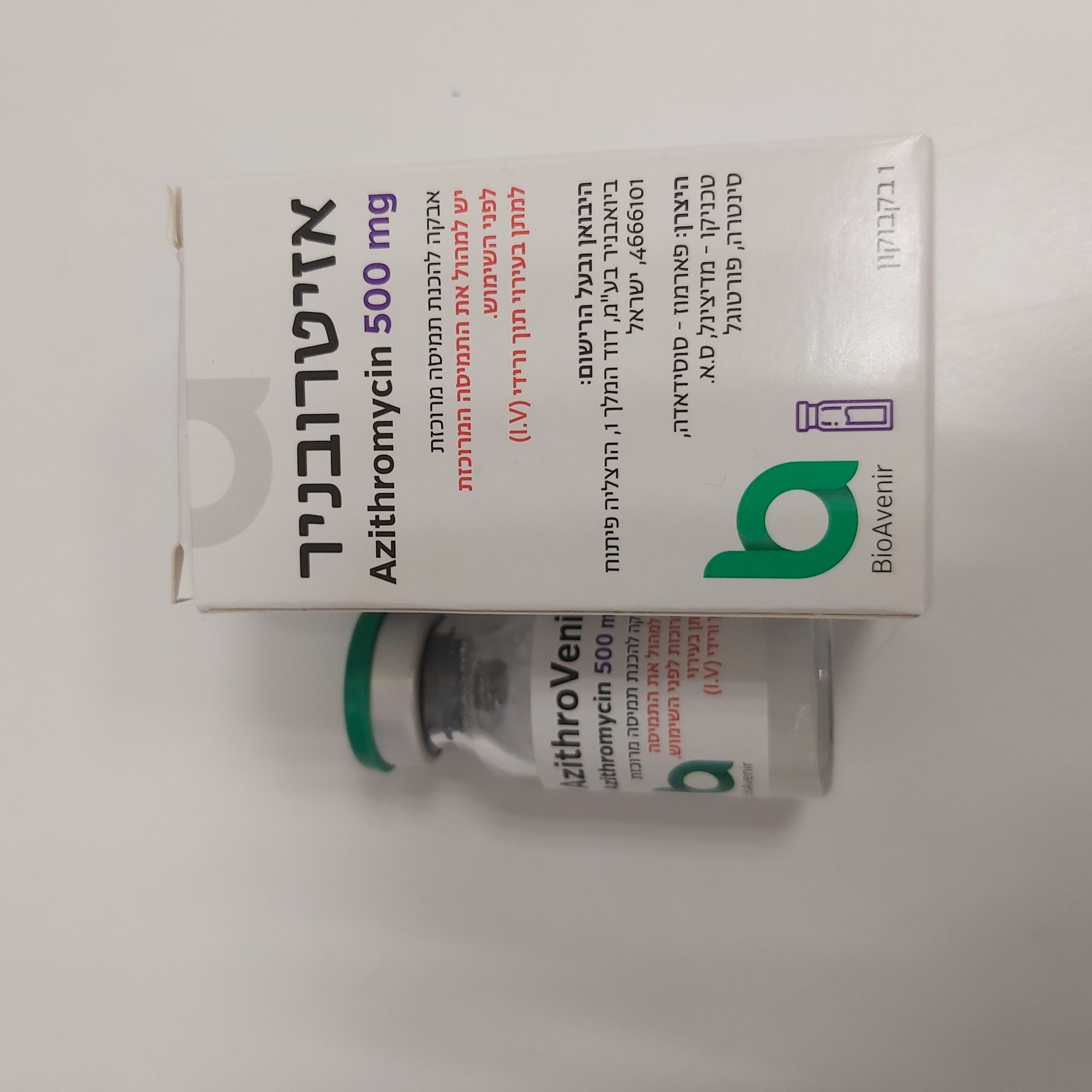Quest for the right Drug

אזיטרובניר AZITHROVENIR (AZITHROMYCIN AS DIHYDRATE)
תרופה במרשם
תרופה בסל
נרקוטיקה
ציטוטוקסיקה
צורת מתן:
תוך-ורידי : I.V
צורת מינון:
אבקה להכנת תמיסה מרוכזת לעירוי : POWDER FOR CONCENTRATE FOR SOLUTION FOR INFUSION
עלון לרופא
מינוניםPosology התוויות
Indications תופעות לוואי
Adverse reactions התוויות נגד
Contraindications אינטראקציות
Interactions מינון יתר
Overdose הריון/הנקה
Pregnancy & Lactation אוכלוסיות מיוחדות
Special populations תכונות פרמקולוגיות
Pharmacological properties מידע רוקחי
Pharmaceutical particulars אזהרת שימוש
Special Warning עלון לרופא
Physicians Leaflet
Posology : מינונים
4.2 POSOLOGY AND METHOD OF ADMINISTRATION For the treatment of adult patients with CAP due to the indicated organisms, the recommended dose of intravenous azithromycin is 500 mg as a single daily dose by the IV route for at least two days. Intravenous therapy should be followed by oral azithromycin at a single daily dose of 500 mg to complete a 7 to 10 day course of therapy. The timing of the conversion to oral therapy should be done at the discretion of the physician and in accordance with clinical response. For the treatment of adult patients with PID due to the indicated organisms, the recommended dose of intravenous azithromycin is 500 mg as a single dose by the IV route for one or two days. Intravenous therapy should be followed by azithromycin by the oral route at a single daily dose of 250 mg to complete a 7-day course of therapy. The timing of the conversion to oral therapy should be done at the discretion of the physician and in accordance with clinical response. If anaerobic microorganisms are suspected of contributing to the infection, an antimicrobial anaerobic agent may be administered in combination with azithromycin. After reconstitution and dilution, the recommended route of administration for intravenous azithromycin is by IV infusion only. Do not administer as an intravenous bolus or an intramuscular injection. The infusate concentration and rate of infusion for azithromycin intravenous (IV) should be either 1 mg/ml over 3 hours or 2 mg/ml over 1 hour. An intravenous dose of 500 mg azithromycin should be infused for a minimum duration of one (1) hour. In Children: The safety and efficacy of intravenous azithromycin for the treatment of infections in children has not been established. SPECIAL POPULATIONS: In the Elderly: The same dosage as in adult patients is used in the elderly. Elderly patients may be more susceptible to development of torsades de pointes arrhythmia than younger patients (see 4.4 Special Warnings and Precautions for use ). In Patients with Renal Impairment: No dose adjustment is necessary in patients with mild to moderate renal impairment (GFR 10 - 80 ml/min). Caution should be exercised when azithromycin is administered to patients with severe renal impairment (GFR < 10 ml/min) (see 5 Clinical Pharmacology). In Patients with Hepatic Impairment: The same dosage as in patients with normal hepatic function may be used in patients with mild to moderate hepatic impairment. Since azithromycin is metabolised in the liver and excreted in the bile, the drug should not be given to patients suffering from severe liver disease. No studies have been conducted regarding treatment of such patients with azithromycin (see Contraindications [4.3,]). Preparation of the Solution for Intravenous Administration Reconstitution: Prepare the initial IV solution for infusion by adding 4.8 ml of sterilized Water for Injection to the 500 mg vial and shaking the vial until all of the drug is dissolved. Since azithromycin IV is supplied under vacuum, it is recommended that a standard 5 ml (non-automated) syringe be used to ensure that the exact amount of 4.8 ml of sterilized Water for Injection is dispensed. Each ml of reconstituted solution contains 100 mg azithromycin. Chemical and physical in-use stability of the reconstituted product has been demonstrated for 24 hours at below 250C. When diluted according to the instructions, the diluted solution is chemically and physically stable for 24 hours at 250C and for 7 days at 2-8 0C. From a microbiological point of view, the product should be used immediately. If not used immediately, in-use storage times and conditions prior to use are the responsibility of the user and would normally be no longer than 24 hours at 2 to 8°C, unless reconstitution and dilution have taken place in controlled and validated aseptic conditions. Dilute this solution further prior to administration as instructed below: Dilution: To provide azithromycin over a concentration range of 1.0-2.0 mg/ml, transfer 5 ml of the 100 mg/ml azithromycin solution into the appropriate amount of any of the diluents listed below: Final Infusion Solution Concentration (mg/ml) Amount of Diluent (ml) 1.0 mg/ml 500 ml 2.0 mg/ml 250 ml The Reconstituted Solution can be diluted with: Normal Saline (0.9% sodium chloride) ½ Normal Saline (0.45% sodium chloride) 5% Dextrose in Water Lactated Ringer’s Solution 5% Dextrose in ½ Normal Saline (0.45% sodium chloride) with 20 mEq KCl 5% Dextrose in Lactated Ringer’s Solution 5% Dextrose in 1/3 Normal Saline (0.3% sodium chloride) 5% Dextrose in ½ Normal Saline (0.45% sodium chloride) Parenteral drug products should be inspected visually for particulate matter prior to administration. If particulate matter is evident in reconstituted fluids, the drug solution should be discarded. DOSAGE FORMS AND STRENGTHS Azithromycin dihydrate 524.1 mg equivalent to 500 mg azithromycin base. Azithromycin is supplied in lyophilized form under a vacuum in a 10 ml vial equivalent to 500 mg azithromycin for intravenous administration. Upon reconstitution, azithromycin powder yields a solution containing the equivalent of 100 mg azithromycin per 1 ml.

שימוש לפי פנקס קופ''ח כללית 1994
לא צוין
תאריך הכללה מקורי בסל
לא צוין
הגבלות
לא צוין
מידע נוסף
